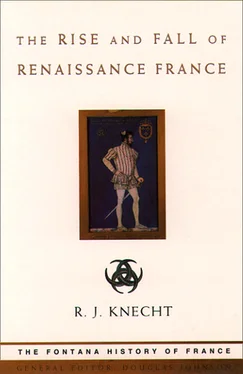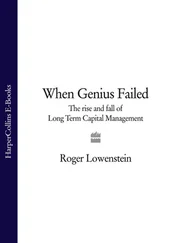The University of Paris, which had been founded in the twelfth century, was best known for its faculties of theology and arts. It also had faculties of canon law and medicine. In the fifteenth century its reputation declined and it ceased to attract as many foreign students as in the past. While degrees were conferred by the faculties, teaching was done in fifty or so colleges. The most famous were the Sorbonne and the colleges of Navarre, Cardinal Lemoine, Sainte-Barbe and Montaigu. Not all students lived in them; many lodged in ‘digs’ some of which were run by their tutors. For physical exercise the students could use the Pré-aux-Clercs, a large meadow just outside the Porte de Nesle.
The rise in population, growth of urbanization and a general rise in the standard of living were mainly responsible for an economic boom that lasted from the 1460s until the 1520s. France was fortunate in being largely self-sufficient in respect of basic necessities. Grain was her chief product. Though she sometimes had to import foreign grain, this was only in times of famine; normally she produced enough for her own needs and exported any surplus. Wine consumption increased hugely during the sixteenth century, as shown by the rapid expansion of vineyards around Paris, Orléans, Reims and Lyon, by the yield from duties on wine and by the multiplication of taverns. Then as now, wine was produced not only for the home market, but for export. Several major vineyards were developed along the Atlantic coast around Bordeaux, La Rochelle and in the Basse-Loire. England and the Netherlands were the best customers.
Salt, like wine, was produced for markets at home and abroad. From marshes along the Mediterranean coast, it was sent up the Rhône and Saône to south-east France, Burgundy, Switzerland and Savoy. Another group of salt marshes along the Atlantic coast supplied a much wider area, including northern France, England, the Netherlands and Baltic states.
Metalware, especially of iron or steel, was not widely used in late medieval France. Agricultural and industrial tools were still usually made of wood. Apart from a few basic iron pots, the greatest demand was for nails and pins. For non-ferrous metals, France depended largely on foreign imports: copper, brass and tinplate from Germany, pewter and lead from England and steel from Italy.
As trade developed in France around the close of the Middle Ages, no fewer than 344 markets and fairs were set up under royal licence between 1483 and 1500. A fair was given privileges designed to attract foreign merchants: for example, foreign money was allowed to circulate freely, the goods of aliens were guaranteed against seizure and distraint, and the droit d’aubaine , whereby an alien’s inheritance was liable to forfeiture by the crown, was set aside. Some fairs were exempted from entry or exit dues and sometimes special judges were appointed to hear the suits of merchants, thereby sparing them the delays of ordinary justice.
By 1500 most big towns and many smaller ones had fairs. The most famous were the four annual fairs of Lyon, which drew many foreigners, especially Italians, Germans and Swiss. They were also important to the history of banking. Though banks had existed in France since the thirteenth century, they only became important as agencies of credit and exchange in the fifteenth century. They fixed themselves in Lyon because of the large amount of business transacted there, and threw out branches in other trading centres. The use of bills of exchange eliminated the need to carry large amounts of cash, and the fairs of Lyon became a regular clearing house for the settlement of accounts. At the same time, bankers took money on deposit, lent it at interest and negotiated letters of credit.
French overseas trade had recovered from the stagnation it had suffered during the Hundred Years War. The annexation of Provence in 1481 was extremely significant for French trade in the Mediterranean. Although Marseille failed to wrest the monopoly of Levantine trade from Venice, it established useful links with the ports of the Ligurian coast, Tuscany, Catalonia, Sicily, Rhodes and the Barbary coast. The chief traders were Italians who looked to the bankers of Lyon for capital. The French Atlantic and Channel ports also recovered in the late fifteenth century and traded actively with England, Spain, the Netherlands and Scandinavia. As land communications were poor, harbours developed along the west coast, along navigable rivers and even far inland. As many as 200 ships might be seen at any time along the quays at Rouen. The most important port of the south-west was Bordeaux which was visited by an English wine-fleet each year.
The expansion of trade was linked to industrial growth. Cloth-making, which was centred in northern France but becoming entrenched in other areas, notably Languedoc, was France’s chief industry. Although often named after the towns from which the cloth-merchants operated, the various kinds of cloth were produced mainly in the countryside. French cloth was, generally speaking, of ordinary quality and cheap, serving the day-to-day needs of the lower social strata. Even the best French cloth could not compete with such foreign imports as Florentine serges. The finest wool was imported from Spain, England, the Barbary coast and the Levant. An important development was the establishment of a luxury textile industry, first at Tours, then at Lyon. But France alone could not satisfy the increasingly sophisticated tastes of the court and nobility. For the finest linen she looked to the Netherlands and South Germany and for silks to Italy – velvet from Genoa, damask and satin from Florence and Lucca, and cloth of gold from Milan.
An industry that was developing fast in France around 1500 was printing. After its importation from Germany in 1470, it spread to Lyon in 1473, Albi in 1475 and Toulouse and Angers in 1476. By 1500 there were 75 presses in Paris alone. France still lagged behind Italy in book production, but it was catching up fast. Thus between 1480 and 1482, Venice produced 156 editions and Paris 35; between 1495 and 1497, Venice produced 447, Paris 181 and Lyon 95. Whereas in 1480 only nine French towns had printing presses, by 1500 the number had risen to 40. Although French printers began by targeting academic clients, they soon branched out in pursuit of bigger profits. In addition to classical and humanistic texts, they published all kinds of religious works and also secular works, like tales of chivalry.
French society in the late Middle Ages was far simpler structurally than it is today. It consisted mainly of peasants, who lived in the kingdom’s 30,000 villages. A village was largely self-contained: if it looked outwards at all, it was only to the neighbouring parishes or to the nearest bourg with its market and lawcourt. Yet some peasants did venture further afield. Each year, for example, thousands of Auvergnats took up seasonal work in Spain while teams of Norman peasants helped to bring in the grain harvest in Beauce and the Ile-de-France. But most peasants stayed in or near their birthplace.
Each village had its own hierarchy. At the top was the seigneur, who was usually but not always a nobleman, for a seigneurie was purchasable like any other piece of property. It comprised a landed estate of variable size and a judicial area. The estate was usually in two parts: the demesne, which included the seigneur’s house and the tribunal as well as the lands and woods he cultivated himself; and the censives or tenures , lands which he had entrusted in the past to peasants so that they might cultivate them more or less freely in return for numerous obligations, called redevances. The main one was the cens , an annual rent, often quite light, which was paid on a fixed day. The seigneur usually retained the mill, wine-press and oven, and expected to be paid for their use. He took a proportion of any land sold, exchanged or inherited by a censitaire , and exacted champart , a kind of seigneurial tithe, at harvest time. The seigneur also had certain judicial powers. Usually he had surrendered his criminal authority to the royal courts, but he continued to act in civil cases through his bailli and other officials. His court judged cases arising among the censitaires but also between them and himself. Almost inevitably in a country as large as France, seigneuries did not exist everywhere: in the centre and south there were freehold lands ( alleux ) which were totally free of seigneurial dominance. By contrast, Brittany and Burgundy were oppressively seigneurial.
Читать дальше












